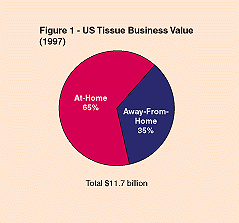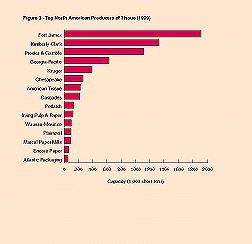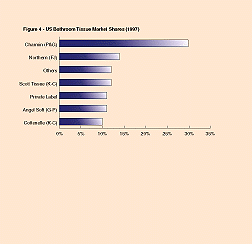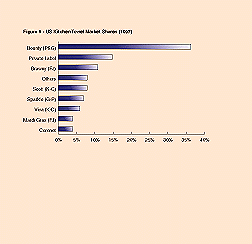|
Tissue market characteristics are changing at a rapid pace in North America and the trends are likely to spread elsewhere
The US tissue market is providing a new benchmark
The US tissue market is not only the biggest in the world, it is also alive and kicking in its maturity. While the growth rate steadied during the 1990s and per capita consumption settled at 42.6 lbs (21.3 kg), the present level is so high that many nations may never reach it. In comparison, the per capita consumption forecast for Western Europe is 31.9lbs (14.5 kg) for the year 2005, which is the same as the US per capita figure in 1970.
In the US marketplace, the outlook for tissue is positive. The question is no longer how much more one can consume, but what product one wants to consume. Tissue in the form of bathroom tissue, towels, napkins and facial wipes all have different usage patterns as well as growth rate characteristics. Looking back 12 years, the only per capita growth has taken place in bathroom tissue (4.2 lbs) and towels (2 lbs). Future growth is expected to focus on these products in addition to napkins in the away-from-home segment.
In volume terms, the US tissue market currently stands at about 5.7 million short tons per year. The at-home or consumer market accounts for about 64% of the volume, while the away-from-home or commercial market is about 36%. Bathroom tissue accounts for 46% of the total, towels for about 35%, followed by napkins at 13% and facial tissue at 6%.
Business values
Tissue product usage in the at-home and away-from-home segments grew by 2.4 % each year during 1985-1997 on average. The main difference is that the growth in the away-from-home market slowed, particularly during the early 1990s, whereas the at-home market continued its steady pace. One of the key contributing factors is the change in employment patterns from office to home.
By product group, there are interesting developments as well. Bathroom tissue accounts for about $3.4 billion, ie 50% of the value in the at-home market. Kitchen towels are the second biggest category at $2.3 billion, while facial products account for about $1.1 billion and napkins make up $0.6 billion of the at-home market.
The top three tissue producers account for about 60% of North American tissue capacity. The industry is divided into those who primarily or exclusively operate in the at-home consumer business and those who similarly operate in the away-from-home segment. Both segments are highly concentrated, with just four producers responsible for 80% of each market. Fort James, Kimberly-Clark and Georgia-Pacific have some flexibility to optimize production by shifting between segments.

Fort James is clearly the industry leader in terms of installed capacity in North America. The group has approximately 30% of the market share in the consumer segment and a 40% share in the commercial side. Fort James is the leading brand producer with the value price Mardi Gras range, the premium price Northern and super premium Vanity Fair brands. In addition to its branded product sales, Fort James is also the biggest private label producer of bathroom tissue and towels in the USA.
Kimberly-Clark is the second major player. It is focused on the consumer market, which commands 70% of sales, with the remainder going to the commercial sector. Kimberly-Clark is a brand provider (eg Kleenex, Scott) that is also involved in personal care products such as diapers, baby wipes, incontinence products, etc.
Procter & Gamble is the leading US consumer goods company with well known tissue brands such as Charmin and Bounty. Georgia-Pacific and Chesapeake come into the range of medium-sized tissue producers.
As the consumption of tissue paper is heavily concentrated on the US east coast, the population of mills is high in the area. The northeast has a higher concentration of smaller regional players, with many using recovered fiber. In the US south, the mills tend to be significantly larger and are based on virgin fiber.
Quality tiers
Economy, value, premium and ultra are the four quality tiers most often referred to in the sector. A crucial marketing requirement is to position a brand so that its price/performance characteristics meet consumer expectations relative to competition for its quality tier.

In bathroom tissue, the premium and ultra qualities account for about half of the value. These top quality tiers, compared to value and economy tiers, have offered the most growth in the recent past and are most likely to do so in the future. Quality means the right combination of softness, strength, absorbency and image. Contrary to development trends in certain European countries where quality improvements are gained via 3-4 ply structures, the US market is led by 1-2 ply ultra soft tissue products.
Procter & Gamble and Kimberly-Clark dominate the premium and ultra segment. The product offerings from Fort James cover this segment as well, but to a lesser extent. Kimberly-Clark and Fort James are the only producers with coverage across all quality tiers.
Most private label producers - American Tissue, Chesapeake, Marcal etc - have capabilities to serve only lower quality market segments. However, there has been a successful entry into the premium tier by Potlatch, primarily serving western markets.
One development trend in the away-from-home market is the segmentation of products targeted across the range of high-end (luxury hotel chains and restaurants) and low-end (office buildings and industrial complexes) end-users.
Ad spend
Significant marketing expenditures are essential to create and maintain consumer brand awareness and loyalty and spending on advertising correlates well with brand market share.
The scale of the US tissue industry's adspend is enormous relative to other parts of the world, exceeding $200 million. In the US, Procter & Gamble spends over $125 million advertising tissue products, or 1-2% of tissue sales. Major spending is for brand leaders and premium products such as Charmin (bathroom tissue) and Bounty (towel). Typically, the adspend is 3-4% of the sales of the leading brands. In contrast, advertising expenditure for economy and value quality products is considerably lower.
It is quite evident that there are quite a few different things that one could do with $125-170 million, some of which are very concrete, while others are completely abstract. By allocating $125 million for consumer advertising campaigns (TV shots, radio, direct mail, printed media), Procter & Gamble "invests" in building brand loyalty. In comparison, a new world-scale tissue machine investment is worth about $170 million. Or failing that, $147 million one could buy an entire business entity, such as Plainwell did when it acquired Pope & Talbot in 1998.

Ultimately, achieving consumer loyalty through significant adspend is the most important factor that differentiates tissue from other paper grades, particularly in the US. As a result, the leading US tissue industry players are highly skilled at allocating and focusing advertising resources and are expected to leverage this capability as they expand into new geographic regions.
Brands vs private labels
Brands are the darlings in the tissue business, accounting for about 75-80% of the consumer market. The balance is provided by private label products. There are interesting differences between brands, products and regions. Private labels are more common in the west than in the east. The situation for Europe is quite different as the share of private labels is higher, and contrary to US developments, the pace of private label growth has matured.
Bathroom tissue, towels and facial products are branded and account for about 80% of US at-home tissue sales. By contrast, the $550 million napkin category is dominated by value-conscious brands, where private label products lead the category with a share of about 30%.
There are relatively few brands in the US, compared to western Europe. In bathroom tissue, the number of really meaningful brands is about 10, while this rises to about 12 for kitchen towels.
Merger and acquisition activity has cut down the number of brands, but it has also given birth to the licensing of brands. The notion is that brands are costly to launch and maintain, since it is a challenge to earn a market share in a slowly growing market.
Brand extensions
Kleenex Cottonelle is a ribbed single-ply bathroom tissue positioned at the premium level and appeared to be a success in the marketplace. But Procter & Gamble's Charmin bathroom tissue is set to raise the competitive bar when it is launched in May, with significant product improvements in bulk, softness and strength. On the other hand, the US market has witnessed limited acceptance of the moist bathroom tissue segment, where examples include Moistmates or the Kleenex version.
In kitchen towels, "rinse and reuse Bounty" from Procter & Gamble has proved to be hit in the markets. In facial tissue, a new concept has been launched - namely, "Purely Cotton" - positioned as ultra quality facial tissue. It is made out of cotton linters and is marketed and produced by Linters Inc.
Procter & Gamble is extending its Bounty kitchen towel brand with a test of Bounty Quilted Napkins. P&G is looking to set Bounty napkins apart with claims for strength and durability in a category where brands are positioned primarily on value or elegance. The launch of the new napkins will also be supported by advertising - a novel tactic as advertising support has rarely been used in the napkin segment.
Branded products dominate the distribution channels. They have particularly strong positions in the mass merchant area, followed by food retailers and drug stores. The share varies from 83% to 78% of tissue products sold.
The share of private label products has grown in the food retailer segment to more than 20%, while it is also up on the drug store front (again over 20%). Mass merchants rely on branded products (about 83% of sales).
Reaching out
Looking at the distribution channels, food retailers account for some 66% of the at-home tissue sales in the USA. Mass merchants account for about 29% of the sales followed by drug stores at 5%. The sales distribution has changed somewhat in favor of the mass merchants.
Online grocery shopping, currently in its infancy, is likely to change the traditional retailing business. The independent online grocers - Peapod and NetGrocer - are leading the way to where consumers may order using personal computers, scanner pens and/or interactive TV as their ordering mechanism. With these devices, consumers could order core items without going to a traditional store. One school of thought expects the effect on the brands and brand awareness will be immense, since more products will be bought based on brand loyalty.
In contrast, the traditional large US grocery retailers are also examining the potential of online shopping and may eventually offer these services as an extension to their neighborhood stores. The impact here may be to favor the retailers' own private label brands of tissue.


Leading the pack
Larger multipacks have become more prevalent. The standard four pack configuration has become less significant as the larger "big box" mega-stores, club stores and mass merchandisers increase their share of the retail market. Package counts of 12 to 48 are favored for bathroom tissue, while a 6 to 15 count is favored for towels. The minibundle is also new for bathroom tissue, which comprises a 4-pack inside a 24-36 count unit. In towels, there are now single roll wraps inside 6-15 count rolls. In addition, mega-pallets are gaining ground instead of case packers.
Seasonal products are one of the hot items in the tissue business. Stunning graphic designs and packages especially for major holidays or seasonal themes like Thanksgiving, Christmas, Easter and summer designs for facial tissue boxes and napkin prints are common. The Scott Canada approach also provides an interesting example. Rosedale Decorative Products is a leading North America designer, developer and distributor of wall coverings and related accessories and the group has set up a licensing agreement with Scott Paper (subsidiary of Kruger). Under the three-year agreement, Scott Paper will feature some of Rosedale's best selling designs on Scotties - its top facial tissue brand sold in Canada.
A mature market usually has the connotation of being staid and static. For the US tissue market and the industry that supports it, there is no doubt that quite the opposite is true. Increased industry consolidation has benefited the consumer as competition has become more dynamic. More attention is being paid to getting better advertising and promotional programs working in conjunction with improved products.
This process is being led by highly skilled, customer-oriented companies. And as these firms expand across the globe, the "bag of tricks" that they have learned and applied so well in the USA are likely to be leveraged into other countries and regions. n
This article was written by Soile Kilpi, VP (SKK@poyryusa.com) and Gary Helik, SVP (JGH@poyryusa.com) at Jaakko Pöyry Consulting (North America), located in Tarrytown, New York, USA
|